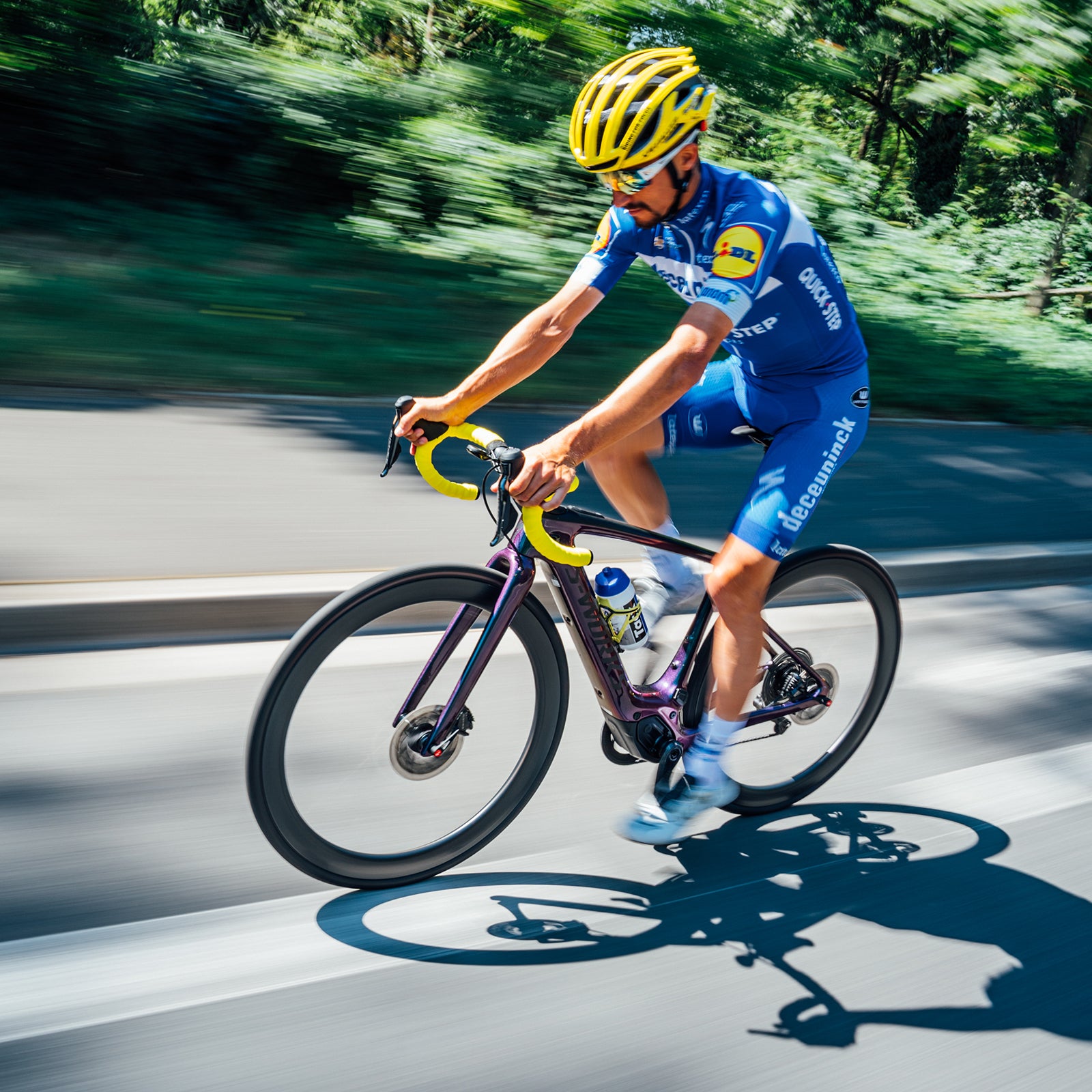I’ll be the first to admit it: Specialized’s new Creo e-road bike is pretty damn cool.
Start with the sleek industrial design, which is one of the key factors that separates the company from many of its competitors. Many e-bikes look like, well, electric bikes,��with bulbous external batteries or internal ones poorly hidden within comically oversize��frame tubes, not to mention exposed wiring and clunky bar-top display and control units. Even middrive (bottom-bracket-mounted) motors are usually pretty obvious. The Creo, on the other hand, is so beautifully proportioned that you do a double take: That’s an e-bike? Specialized incorporated the battery, the controller, and even the motor with a purposeful elegance that will be essential to broadening the popularity of e-bikes, especially among the tradition-minded roadie crowd.
Many cycling-media outlets,��, greeted the launch with great enthusiasm. But is it really , as they say?��No.
It’s too expensive, and it’s aimed at the wrong group of people. The e-bike that will change everything does not exist yet. If and when it does, it’s not going to be a $13,000��road bike.��
Certainly, the Creo represents some significant technological advancements. Bike maker and designer Keith Bontrager is famous for the aphorism��“Light.��Strong. Cheap.��Pick two.” For e-bikes, you could amend that to: light, powerful, long-lasting��battery.��
Where many brands struggle to deliver two of those attributes, the Creo nails all three��(although��I haven’t ridden it; that’s based on assessments��by��people who have). The S-Works model, at least, weighs a claimed 27 pounds, lighter than almost anything else in its class. And you get up to 240 watts of power assist, with a cutoff-assist speed of 28 miles per hour, and a range of up to 80 miles on the main battery.��
The Creo’s compromise is cost: $9,000 to start. The $13,000 S-Works model is significantly pricier than almost any other performance e-road bike on the market. There’s even a ridiculous Founders Edition that will be available in limited numbers (250) and will cost $16,500.
It’s an e-bike for people who are already devoted, hardcore road cyclists—a niche audience within an already niche audience. I’d guess that most of the buyers will be well-to-do longtime roadies who are finding that their own��human-powered output is��dropping��but have so far been put off by aesthetics, meager range, or low cutoff-assist speeds of models like the��Pinarello��Nytro. This is a small group of buyers whose every year.
Sure, the Creo stands to keep more people on bikes for longer, because it enables cyclists to keep pushing in the face of eroding physical abilities. Its sleek looks and smooth ride��may��also entice some modest number of wealthy folks into a sport they might not otherwise have tried. But that’s a kind of rearguard action that slows the rate of ridership decline rather than reversing��it.
That’s not to say the Creo will have no effect on e-bikes. At some point, the advances that Specialized is achieving with the Creo should pop up in its more affordable e-bikes, like the urban-oriented Turbo Vado, although trickle-down takes time. Other companies will also certainly respond to Specialized’s new benchmarks on metrics like range and weight (those gains are already happening across brands).��
And with its proprietary motor, remote controller, wiring, and charger, the Creo may also drive e-bikes to become less plug and play and more closed ecosystems.��(Most bike brands use motors and batteries from an outside supplier, like Bosch or Shimano, which can be swapped in at will.) This would limit consumers’ ability to customize their machines��but afford better functionality.
The e-bike that will change everything does not exist yet. If and when it does, it’s not going to be a $13,000 road bike.
Most significantly, the Creo will change what people expect from e-bikes in terms of form, feel, and function. It’s worth a reminder that the iPod was not the first portable MP3 player. Apple just created a far better user experience than any of its competitors. You knew how to use an iPod innately, and iTunes meant you could buy music without worrying whether a download came with malware. Before long��those distinctive white earbud cords became a .��
That’s the dynamic that Specialized has started to tap into here. When an e-bike looks really sweet, is intuitively easy to ride, and the buying experience is seamless and friendly, people—especially those who don’t already ride and can’t or won’t invest in a top-dollar machine—will be much more receptive.
Unfortunately, the Creo is not that bike. I’ll bestow the term “game changing” on the first e-bike that has all of those attributes, is designed for everyday urban use, and costs $1,000. It won’t be marketed at cyclists, designed for them, or likely even sold in traditional bike shops. It’ll be aimed almost entirely at people who don’t ride at all, many of whom balk at the idea of paying four figures for a two-wheeled��vehicle.
There are $1,000 e-bikes right now. But most of them look like crap and use motor systems of varying provenance and quality. That said, the $1,000 barrier is closer than you might think. Spend $400 more and you can get something like the Aventon Pace 500, a sleek Class 3 machine (pedal assist to 28 miles per hour).��Yes, it uses a rear-hub motor, which is typically noisier, unbalances the bike weight, and has a jerkier, less natural sensation than middrive systems. But if a small, new brand like Aventon can get this close, what could a brand with Specialized’s size and resources achieve in, say, two years of dedicated work?
I’ve always been mystified by the fact that traditional bike brands seem to ignore the potentially massive new market that a quality, affordable e-bike might open up. I suspect the problem is largely one of focus and perspective. Brands like Specialized are founded, run, and staffed by bike nerds who make bikes with nerdy attributes—stiffer! more aerodynamic!—that appeal to other bike nerds.��
Reaching people who don’t already share that same love for bikes or identify as a cyclist��remains somehow beyond their grasp. The giveaway is right there in the marketing tagline for , even its��urban bikes: You, Only Faster.��And who are the consumers who care about going fast?��Cycling enthusiasts.��
Bike companies like to talk a big game about encouraging more people to ride bikes. They’re members of advocacy organizations like PeopleForBikes.��They support grassroots outfits like the National Interscholastic Cycling Association, which has grown mountain-bike racing more effectively the past ten years than has in 30. And in some cases, , they even have their own foundations devoted to kids’ cycling, in service of public health.��
But that mindset somehow gets lost when it comes to making and selling e-bikes, especially ones for urban use, which is the category that’s most likely to create new cyclists. Pump all the cash you want into advocacy, but for a bike company, the straightest line to getting more people on bikes is making bikes people want and can afford. Specialized’s cheapest e-bike model costs $2,550, about in the U.S. If that doesn’t sound like much, consider what items, other than basics like food and housing, you’d spend that kind of cash on if you didn’t have to.
Sure, bikes like the Creo are expensive partly because the brand has to amortize their considerable research and development costs. But Specialized can recover that cost in two ways: selling a few Creos at astronomical prices��or selling thousands of a more affordable urban e-bike.��
Bike industry: Build this bike.��Build it and fight climate change. Build it and make cities more livable. Build it to provide a real option for people who can’t afford, or don’t want, a car. Build it and improve public health. Build it and open up the world of cycling so people who don’t already ride can experience how, for almost any challenge we face as a society, bicycles can be part of the solution.


